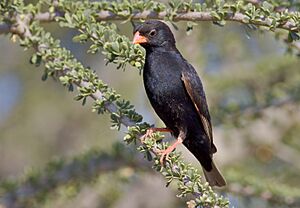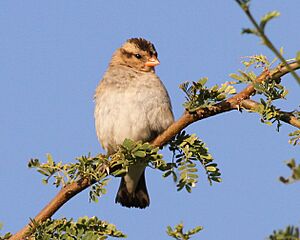Village indigobird facts for kids
Quick facts for kids Village indigobird |
|
|---|---|
 |
|
| Male of the red-billed race (V. c. amauropteryx) in Mapungubwe N. P. | |
 |
|
| Female in Mapungubwe N. P. | |
| Conservation status | |
| Scientific classification | |
| Genus: |
Vidua
|
| Species: |
chalybeata
|
The village indigobird (Vidua chalybeata) is a small songbird. It is also known as the steelblue widowfinch. In some places, it's called the Combassou finch. This bird belongs to the Viduidae family.
You can tell the village indigobird apart from other indigobirds. Look at the color of its beak and legs. Also, the male's feathers during breeding season have a special shine. Their songs are different too. Even the patterns inside a baby bird's mouth can help tell them apart. Some village indigobirds have red beaks, while others have white beaks. The color of the male's feathers can also change slightly depending on where they live.
Contents
Where They Live and What They Like
The village indigobird lives in most parts of Africa. You can find them south of the Sahara Desert. They are a "resident breeding bird," which means they live and have their babies in the same area all year.
These birds like many open places. This includes open forests, bushy areas, and farms. But, as their name suggests, you will most likely see them near villages.
Life Cycle and Raising Young
The village indigobird is a special kind of bird called a brood parasite. This means it lays its eggs in the nests of other birds. It uses the nests of red-billed firefinches.
- The indigobird does not break the firefinch's eggs.
- It usually adds 2 to 4 of its own eggs to the nest.
- Both the indigobird's eggs and the firefinch's eggs are white.
- The indigobird's eggs are a little bit bigger.
When baby indigobirds hatch, they are very clever. They copy the unique mouth pattern of the firefinch babies. This helps the firefinch parents not notice the extra babies in their nest.
How They Behave
Male village indigobirds are very protective of their space. They have a fancy dance they do to attract a mate. The male sings his song from a high spot. His song is a mix of fast, sputtering sounds. It also includes sounds that copy the red-billed firefinch's song. A common sound they mimic is the firefinch's "chick-pea-pea-pea."
These birds mostly eat seeds and grains.
What They Look Like
The village indigobird is a small bird, about 11 to 12 centimeters long.
Male Village Indigobird
- The adult male is mostly greenish-black or bluish-black.
- He has bright orange-red legs.
- His beak is white and shaped like a cone.
Female Village Indigobird
- The female looks a bit like a female house sparrow.
- Her upper body is brown with stripes.
- Her belly is a pale yellow-brown color.
- She has a whitish stripe above her eye.
- Her beak is yellowish.
- Like the male, she also has red legs.
Young Village Indigobirds
- Young birds look like the female.
- They are plainer and do not have the stripe above their eye.
Many indigobird species look very similar. It can be hard to tell the males apart in nature. It's even harder to tell the young birds and females apart. Here are some tips for spotting a village indigobird:
- They are often found near their host bird, the red-billed firefinch.
- They are usually seen close to human villages.
Different Types of Village Indigobirds
There are six recognized types, or "races," of the village indigobird. They have slight differences in where they live and what they look like.
- V. c. subsp. chalybeata (Müller, 1776)
- Lives in West Africa, from Senegambia to central Mali.
- Males have green, greenish-blue, or green-hued feathers.
- They have white beaks.
- V. c. subsp. neumanni (Alexander, 1908)
- Lives from Mali to South Sudan.
- V. c. subsp. ultramarina (J. F. Gmelin, 1789)
- Lives in Ethiopia and Eritrea.
- V. c. subsp. centralis (Neunzig, 1928)
- Lives in the Democratic Republic of Congo, Uganda, Kenya, and Tanzania.
- V. c. subsp. okavangoensis Payne, 1973
- Lives from western Angola to northern Botswana.
- These birds can have red or white beaks.
- Males have blue-hued feathers.
- V. c. subsp. amauropteryx (Sharpe, 1890)
- Lives along the coast of East Africa and in southeastern Africa.
- These birds have red beaks.
- Males have blue-hued feathers.
Gallery






